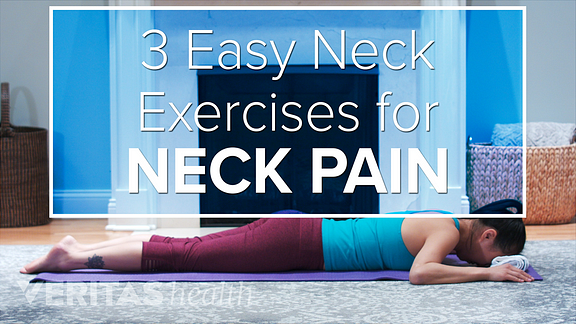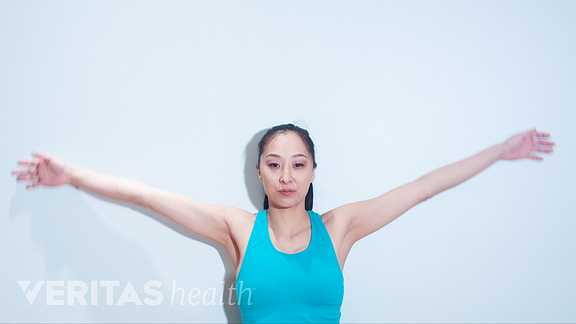When the neck and upper back muscles become weakened, the head sags forward and increased stress is placed on the cervical spine, which can lead to neck pain. Strengthening these muscles can help improve posture and get the head closer to neutral position (with the ears directly over the shoulders).
Chin Tuck
One of the most effective postural exercises for combating neck pain is the chin tuck exercise. This exercise helps strengthen the muscles that pull the head back into alignment over the shoulders (upper thoracic extensors) and also stretches the scalene and suboccipital muscles.
To perform the exercise for the first time, it is typically recommended that patients stand with the spine up against a door jamb and the feet out about 3 inches from the bottom of the door jamb.
- Keeping the spine against the door jamb, pull the upper back and head backward until the head touches the door jamb. It is important to make sure that the chin is down so that the head is pulled straight back and not looking up.
- Hold the head against the door jamb for 5 seconds.
- Repeat this 10 times.
A person may feel some stretching of the scalene muscles on the side of the neck that go down to the collarbone. These muscles along with the suboccipital muscles at the top of the neck and the base of the skull are generally the tight muscles. The muscles in the front of the neck and muscles of the upper back are usually the weak muscles that need to be strengthened.
After initially performing the chin tuck exercise in a door jamb and becoming comfortable with it, the exercise can eventually be done standing or sitting without a door jamb.
Chin tucks can be done five to seven times throughout the day, such as while sitting in the car or at the desk at work. The repetition of this exercise throughout the day also helps develop good postural habits. It is especially important to perform this exercise when the neck and shoulder blades first begin to hurt.
In cases of extreme forward head posture, a person may not be able to pull the head all the way back to the door jamb when first starting. In these cases, it is advisable to pull the head back as far as possible without pain.
Prone Cobra
The prone cobra is a more advanced exercise that strengthens the muscles of the shoulder girdle as well as the neck and upper back. This exercise is done lying on the floor face down and uses gravity as resistance in the strengthening process.
- Lying face down, place the forehead on a rolled up hand towel for comfort.
- Place the arms at the side, palms down on the floor.
- Place the tongue on the roof of the mouth (this helps stabilize the muscles in the front of the neck to assist in strengthening).
- Pinch the shoulder blades together and lift the hands off the floor.
- Roll the elbows in, palms out and thumbs up.
- Gently lift the forehead about an inch off the towel keeping the eyes looking straight at the floor (do not tip the head back and look forward).
- Hold the position for 10 seconds.
- Perform 10 repetitions.
Starting out, it might be hard to hold the position for 10 seconds and repeat 10 times. In which case, the exercise can be done as many times as possible without causing pain, and then resumed in a couple days after giving muscles a chance to repair
Back Burn
The back burn exercise helps to strengthen the back muscles and open up tight chest muscles.
Another important postural exercise is the back burn exercise. This exercise is done standing with the back against a large flat wall and the feet about 4 inches out from the bottom of the wall.
- Assume the same position as the chin tuck exercise with the back of the head against the wall.
- Try to flatten the lower back against the wall.
- Place the elbows, forearms and the backs of the hands and fingers on the wall with wrists about shoulder height.
- Keeping the arms, hands, head and fingers all touching the wall as best possible, slowly slide the hands up above the head and slowly back down.
- Repeat this 10 times, 3 to 5 times per day.
In addition to strengthening back muscles, the back burn also helps open up tight chest muscles.





